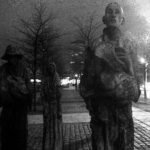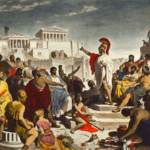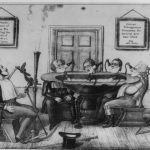In a world popularly obsessed with the occult (the phenoms of Harry Potter and Lord of the Rings come to mind), it seems hardly plausible that the past murders of American “witches” were not only accepted but encouraged in history. For those unfamiliar with the Salem Witch Trials—the killing of 14 women and six men between the years of 1692 and 1693 in Salem, Massachusetts—however, the events are no ghost story.
The years of killing, which began in the spring of 1692 and continued until September 1693, were not unprecedented for the English colonies; the 17th century New England had already seen 14 killings before the Salem Witch Trials. What was particular to this episode was the hysteria created, and the lasting effect it had on the area for centuries to come.
Recommended Reading
The History of Christmas
The Great Irish Potato Famine
Boil, Bubble, Toil, and Trouble: The Salem Witch Trials
The belief in devil possession, worship, and the devil’s ability to transfer powers to people in return for loyalty to him was common as early as 14th century Europe and was strongly held throughout New England during the 17th century as well. With the lingering effects of the French and British war in the American colonies, and the constant threat of Native American ambush, disease, and starvation, the communities in and around Salem were full of tension.
The English settlements in the Americas, and particularly in New England, during the 17th century were predicated on the understanding of religious asylum; Protestants fleeing the Catholic rule of King James II came to the New World to build bible-based communities that were fundamentally Puritan, and dominated by leaders fluent in Calvinism and determined in their conservative leanings. In England during the 1620s and 1630s, the strict Puritan view of Christianity was not supported by the monarchy and while some followers dissented to the Netherlands, most made a mass emigration to the colonies. This emigrant majority formed much of the Massachusetts Bay Colonies and were primarily families, who elected ministers and “freeman” to become the community leaders. Their lives were consumed with survival, agriculture, the safety of their towns from the French and Native Americans, and their religious freedom.
In addition to the religious background of the area, the political turmoil of the region was also a leading factor in the lives of the colonists. The area we associate with the trials is not just one place, but rather a conglomerate of nearby villages: Salem Village (present-day Danvers, Massachusetts), Salem Town (present-day Salem, Massachusetts), Ipswich, and Andover. Many disputes existed between these neighboring communities, including land ownership, grazing rights, property lines, and church rights and privileges. In addition to these disputes, Salem Village decided to elect their own minister in 1692, separate from Salem Town, and subsequently went through a time of turmoil for the next ten years as three ministers were hired and then abdicated the position after only a few years, with one of the ministers tried and killed during the witch hysteria. Many historians believe this climate of social and religious upheaval to be the kindling for the events that would unfold.
The beginning of the Salem Witch Trials is historically set on January 9, 1692, when two young girls, Elizabeth Parris (9 years old) and Abigail Williams (11 years old), the daughter and niece of Samuel Parris, Minister of Salem Village respectively, began having fits. These fits were described as uncontrollable screaming and violent contortions, which led the local doctor, William Griggs, to diagnose bewitchment. Later, in 1976, a study published by toxicologists in Science magazine on the residents of Salem in 1692, attributed the symptoms to the fungus ergot (found in wheat, rye, and other grains common in the early American diet) which can cause symptoms such as muscle spasms, vomiting, and delirium. However, such medical knowledge was unknown, and unprovable, at the time, which lead the diagnosis of bewitching to become an “epidemic” among other young girls in the community. Mary Walcott, Mercy Lewis, Ann Putnam Jr., Elizabeth Hubbard, and Mary Warren also exhibited symptoms and were diagnosed with bewitchment. Later in February, warrants for the arrest of the Parris’ slave Tituba, a homeless woman Sarah Good, and the elderly Sarah Osborn of the community were issued—the young girl, upon feeling better and recovering, had accused them of witchcraft.
Tituba, Sarah Good, and Sarah Osborn were tried before magistrates Jonathan Corwin and John Harthorne, with their accusers in the courtroom with them, exhibiting “symptoms” of spasms and screaming. While both Sarah’s denied their guilt, Tituba confessed and named others within the community working with her alongside the devil. Possibly seeking salvation from conviction by acting as an informer, Tituba’s confessions led to the spread of the witch hysteria throughout the area and culminated in the accusations of other women, including Martha Corey and Rebecca Nurse, who were both considered women of good community and church standing, as well as Sarah Good’s daughter, who was four years old. Like Tituba, many of the accused continued to confess and name others as guilty, and the courts became clogged by the sensational trials. Those who were targeted were generally considered morally weak or socially estranged, and therefore easier to condemn, such as single or outspoken women, the poor, the homeless, or anyone who existed outside of the community conformity. This explains the larger number of women accused, as, under the religious practices of the day, women were considered weaker and more prone to sin.
Latest Society Articles
Who Invented Democracy? The True History Behind Democracy
Medieval Fashion: Tunics, Underclothes, Pointed Shoes, and More!
37 Underground Cities: The Hidden Pillars of Civilization
Due to the overwhelming response of the witch trials, the governor, William Phips, created a special court to hear the cases. The Court of Oyer and Terminer (which included the most famous trials) included the judges Hathorne, Stoughton, and Sewall and was established to hear and decide the witch trails for three counties: Middlesex, Essex, and Suffolk. Their first conviction was that of Bridget Bishop, who they declared a witch on June 2, with a hanging eight days later on June 10, on Gallows Hill in Salem. The numbers after that initial hanging continued to rise and gain speed; with 18 hanged between July and September. There were more killings, however, outside of hangings; seven accused witches passed away while incarcerated, as well as Giles Corey, the husband of Martha, who was stoned to death after refusing to accept a plea.
The minister Cotton Mather and his father, Increase Mather (president of Harvard College) were two local contemporaries that gave little sway to the value of the “bewitching” diagnosis by doctors, and the symptoms of the young girls and spooked townspeople. Together the two urged that evidence be presented at trials, similar to that required of any other trial, which, along with the growing diminishing interest in the trials, led to lesser public support. After reconsidering the support of the community, Governor Phips disbanded the Court of Oyer and Terminer in October of 1693, and by May, Phips had released those accused of witchcraft and had pardoned all of those people who had been killed and brought up on charges.
Four years later, the governing Massachusetts General Court implemented a day of fasting for “the tragedy of the Salem witch trials” and later declared the trails illegal, agreeing to provide financial payment for the family members of those killed and condemned in 1711. This led to an official public acknowledgment and apology from the presiding judge Samuel Sewall, but it didn’t undo the damage caused in the colony by way of community peace.
As a pop culture event, the Salem Witch Trials have, sporadically, brought to the public consciousness a dark and sometimes overlooked event in early American history, one that marked a strong intersection between the medieval thinking of the past and the age of reason and enlightenment that was yet to come.
Explore More Society Articles
The Ultimate History (and Future) of Shaving
Incredible Female Philosophers: Hypatia of Alexandria, Mary Wollstonecraft, and More!
37 Underground Cities: The Hidden Pillars of Civilization
A Brief History of Psychology
The History of Guns in American Culture
Six of the Most (In)Famous Cult Leaders
The unrest and sensationalism caused by the trials continued well into the following centuries for the area, and well into the 20th century by Arthur Miller’s “The Crucible” (1953), which used the hysteria of the Salem trials as an allegory for the political atmosphere and anti-Communist agenda of Senator Joseph McCarthy during the 1950s.
As the modern political climate teeters toward a world consumed with solving community problems by placing blame on an individual, or those individuals who operate outside of the norm, this alarming tale of bewitchment, condemnation, and eventual regret, can be a warning.











is this image real that you used? is it a primary image
Is that image a primary image?
They are real images and yes its a primary image.
Has Salem become a place where today’s ‘witch’ communities a drawn to. If so, what impact has this had on the community outside of a commercial benefit?